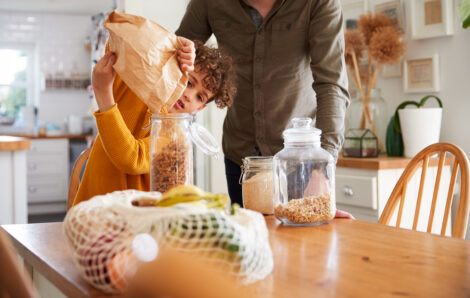Reducing all waste is intimidating. Learning how to start a zero-waste home begins with smaller, manageable steps.
Even though new recycling policies were put in place about a year ago for my region of North Carolina, I have only recently learned about them. My county’s recyclables are now limited to Number 1 and 2 recyclable plastics, newspaper, cardboard, and aluminum cans. The city I live in no longer accepts glass, mixed paper, or plastics 3 through 7.
When I found this out, I was shocked. I thought this was just my county not wanting to spend the money anymore. The real reason for the cutback was the fact that many countries stopped buying our recyclables due to the adverse environmental effects. The U.S. had been selling its plastics to other countries for years. This cutback made me interested in how I can help make up for the extra plastic going to waste in my household.
What are the Barriers Preventing a Zero-Waste Household?
I started to research composting and zero-waste options. The main problems with these options are inconvenience and price. A good composting bin can go for well over 50 dollars. Choosing to go zero waste means you are also very limited with what you can order online as most orders come with lots of extra packaging.
When going to the grocery store, items not in excessive packaging are few and far between, and usually cost a little extra. If you tried to find a bulk store with zero waste options in this town, you would no doubt have trouble. Even when you do acquire the tools to go zero-waste, you have to carry them everywhere you go or risk having to accept plastic that will go in the garbage. Going zero waste and composting also require additional research that many are not willing to do.

Consistent Composting Requires Proper Procedures
A few years back, my family tried composting, but it started to smell unpleasant, so we stopped. It was only recently that I learned how to compost correctly. Proper composting does not cause an odor and is very easy.
I use a bin-style composter. I found a regular tub in my garage and went to work, setting it up. I first layered in brown materials (dirt, twigs, leaves, etc.) and added a little moisture. Then I placed a small bucket in my kitchen, in which my family could put their food scraps. After the bucket is full, I empty it into the compost bin and mix the scraps with the brown materials. It is a very simple process, but even the extra little steps turn people off from composting.
Addressing Garbage at Home
I also recently have started attempting to reduce my trash on a journey to become zero-waste. This concept is often very daunting for most people, and many may think of a video that became viral a while back about a girl who had her trash from the past five years in one mason jar. The truth is zero-waste does not have to be that extreme. I have had metal straws for a while now, and my family uses reusable rags instead of paper towels for the cost-benefit.
To reduce your waste, all you need to do to start is:
- Grab fruits and veggies that don’t come with extra packaging.
- Take a look around before buying something to make sure you are getting the least amount of waste possible.
- Cut back on buying things you don’t need that come with extra packaging.
- Grab a few reusable bags before you head out to the store.
Even these little changes can inspire others to make changes to their lifestyle, too. Sixty percent of trash in United States landfills is plastic or compostable — this shows changes like composting and using less plastic can make a huge difference in how our landfills stack up.

Emma Martin is a junior in high-school who plans to go into college for a degree in environmental engineering. She’s a dancer, a runner, a cheer coach, and an environmentalist whose goal is to make the Earth a better place for all living things.
All MOTHER EARTH NEWS community bloggers have agreed to follow our Blogging Guidelines, and they are responsible for the accuracy of their posts.




